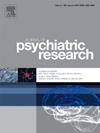Maladaptive Daydreaming among patients with Dissociative Identity Disorder:A prevalence study
IF 3.7
2区 医学
Q1 PSYCHIATRY
引用次数: 0
Abstract
Maladaptive Daydreaming (MD) is a syndrome involving extensive and compulsive absorption in a vivid fantasized world, with detailed and emotional narratives, replacing interest and investment in real life and resulting in clinical distress and functional impairment. It is often accompanied by stereotypical movements (e.g., pacing, shaking one's hand) or movements embodying the daydream. MD shares some characteristics with dissociation in general and Dissociative Identity Disorder (DID) in particular, such as detachment, discontinuities in experience, and a fragmented sense of self, and they may share etiological mechanisms. Previous research found high rates of MD in a sample with severe dissociative disorders. The present study aimed to assess the prevalence of MD in a cohesive DID sample. N = 67 UK-based patients with current DID, confirmed by an interview with a clinician specializing in dissociative disorders, completed self-report scales assessing dissociation and MD. We assessed most of those with high MD scores using a structured clinical interview for MD. We found that at least a quarter of our DID sample had co-morbid MD, although the actual rate was probably closer to 40 %. Correlations from self-report scales indicated that even within this cohesive sample, a tendency for dissociative “absorption and imaginative involvement” was associated with MD symptoms. DID and MD may share common etiological mechanisms, and MD should be screened for in DID, especially in cases of high absorption.

解离性身份认同障碍患者的不适应白日梦:一项流行研究
不适应白日梦症(MD)是一种综合症,涉及广泛和强迫性地专注于生动的幻想世界,具有详细和情绪化的叙述,取代了对现实生活的兴趣和投入,导致临床痛苦和功能障碍。它通常伴随着刻板的动作(例如,踱步,握手)或体现白日梦的动作。MD与一般的解离性身份障碍(Dissociative Identity Disorder, DID),特别是解离性身份障碍(Dissociative Identity Disorder, DID)有一些共同的特征,如脱离、经历的不连续性和自我意识的碎片化,它们可能有共同的病因机制。先前的研究发现,重度分离性障碍患者的MD发病率很高。本研究旨在评估内聚DID样本中MD的患病率。N = 67名目前患有DID的英国患者,通过与一名专门从事解离性疾病的临床医生的访谈证实,完成了评估解离性和MD的自我报告量表。我们使用结构化的MD临床访谈对大多数具有高MD评分的患者进行了评估。我们发现,至少四分之一的DID样本患有合并症MD,尽管实际比率可能接近40%。自我报告量表的相关性表明,即使在这个有凝聚力的样本中,解离性“吸收和想象参与”的倾向也与MD症状有关。DID和MD可能有共同的病因机制,在DID中应该筛查MD,特别是在高吸收的情况下。
本文章由计算机程序翻译,如有差异,请以英文原文为准。
求助全文
约1分钟内获得全文
求助全文
来源期刊

Journal of psychiatric research
医学-精神病学
CiteScore
7.30
自引率
2.10%
发文量
622
审稿时长
130 days
期刊介绍:
Founded in 1961 to report on the latest work in psychiatry and cognate disciplines, the Journal of Psychiatric Research is dedicated to innovative and timely studies of four important areas of research:
(1) clinical studies of all disciplines relating to psychiatric illness, as well as normal human behaviour, including biochemical, physiological, genetic, environmental, social, psychological and epidemiological factors;
(2) basic studies pertaining to psychiatry in such fields as neuropsychopharmacology, neuroendocrinology, electrophysiology, genetics, experimental psychology and epidemiology;
(3) the growing application of clinical laboratory techniques in psychiatry, including imagery and spectroscopy of the brain, molecular biology and computer sciences;
 求助内容:
求助内容: 应助结果提醒方式:
应助结果提醒方式:


